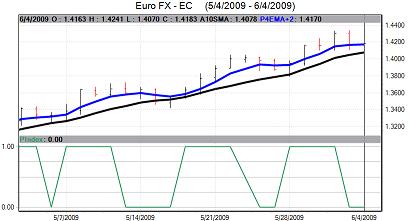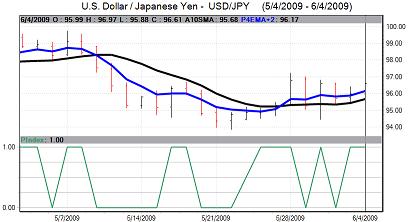As sentiment towards the currency remained extremely weak, the US dollar initially remained under pressure, but it managed to find some respite over the second half of the week with the trade-weighted index securing a fragile recovery from 7-month lows.
The dollar failed initially to secure support from comments backing a strong dollar by US Treasury Secretary Geithner. There were comments from a series of Asian central bank officials in support of the US currency. ECB President Trichet also commented that he recognised the importance of US backing for a strong dollar. The remarks continue to suggest some co-ordinated attempt to support the US currency which provided some near-term dollar support.
Pending home sales increased by a stronger than expected 6.7% in May following a 3.2% increase the previous month and this was the third consecutive increase. The evidence of a sales recovery boosted confidence that the housing sector was recovering and this also triggered a renewed surge in risk appetite.
The US ISM index for the manufacturing sector increased to 42.8 in May from 40.1 the previous month and this was slightly above market expectations. Within the data, the orders component pushed above the 50 level while the prices also strengthened, although the employment component remained extremely weak.
The index for the services sector edged higher to 44.0 for May from 43.7 the previous month. In contrast to recent data releases, however, the improvement fell short of market expectations with the overall index of business activity declining over the month. The latest ADP employment report was also slightly weaker than expected with private-sector job losses of 532,000 for May from a revised 545,000 previously.
The continuing jobless claims data was potentially significant as the number of continuing claims fell to 6.73mn, the first decline since January. This may, however, have reflected the fact that workers are coming to the end of the claims period rather than signalling an improvement.
The non-farm payrolls data was also better than expected with a decline of 345,000 for May, the lowest decline since September, but unemployment rose sharply to 9.4% from 8.9%.

Source: VantagePoint Intermarket Analysis Software
Call now and you will be provided with FREE recent forecasts
that are up to 80% accurate. 800-732-5407
If you would rather have the recent forecasts sent to you, please go here.
The Euro-zone data continued to suggest a measured recovery with the final PMI index for May registering a further small improvement from the provisional figure while retail sales edged higher.
The ECB left interest rates on hold at 1.00% following the latest council meeting, in line with market expectations. At the press conference following the decision, President Trichet was slightly more optimistic over the economy than in recent comments. The forecasts for 2009 were still downgraded by the bank with an estimate that GDP would decline by 5.1% for 2009 with a marginal return to growth for 2010.
The ECB confirmed that it would by EUR60bn in covered bonds with Trichet refusing to make further comments on the possibility of additional purchases.
The Euro strengthened against the dollar with a peak above the 1.43 level before a retreat. There was a mixed performance on the crosses with a solid underlying tone. The Euro rallied following the US employment data, but then weakened back towards 1.40 in volatile trading as rising yields offered some dollar support.

Source: VantagePoint Intermarket Analysis Software
Call now and you will be provided with FREE recent forecasts
that are up to 80% accurate. 800-732-5407
If you would rather have the recent forecasts sent to you, please go here.
The dollar continued to find support on dips towards the 94 level against the Japanese currency and jumped higher in mid-week, although it struggled to maintain the gains with uncertainty over underlying yen direction and consolidated above 96.50 with gains to near 98 after the US payroll data.
The UK data remained stronger than expected with a reported 2.6% increase in house prices for May according to the latest Halifax survey. This was the strongest monthly increase since 2002 which maintained recent optimism over the economy. The latest Hometrack survey also reported the first monthly increase in prices for 20 months
The PMI index for the manufacturing sector rose to 45.4 for May from a revised 43.1 the previous month. The index for the services sector rose to 51.7 in May, the first reading above 50 since March 2008. the construction PMI index rising sharply to 45.9 from 38.1 the previous month which was the strongest level for 12 months. Mortgage approvals also edged higher, although overall consumer borrowing was still at very depressed levels and dampened expectations for a robust economic recovery.
As expected, the Bank of England left interest rates on hold at 0.50% at the latest MPC meeting. The bank also left the amount of quantitative easing unchanged at GBP125bn with the current schedule of bond buying completed within two months.
The bank decision did not have a significant impact on the currency. Sterling strengthened sharply over the first half of the week with fresh 7-month highs against the dollar and Euro and a peak above 1.66 against the dollar. The UK currency then weakened sharply with pressure for a technical correction amplified by increased political tensions as the government remained under pressure.




